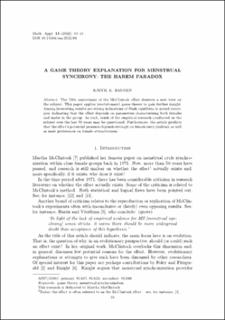| dc.contributor.author | Haugen, Kjetil K. | |
| dc.date.accessioned | 2024-04-16T10:55:27Z | |
| dc.date.available | 2024-04-16T10:55:27Z | |
| dc.date.created | 2022-06-27T08:52:04Z | |
| dc.date.issued | 2022 | |
| dc.identifier.citation | Mathematics for applications. 2022, 11 (1), 33-43. | en_US |
| dc.identifier.issn | 1805-3610 | |
| dc.identifier.uri | https://hdl.handle.net/11250/3126773 | |
| dc.description.abstract | The 50th anniversary of the McClintock effect deserves a new view on the subject. This paper applies (evolutionary) game theory to gain further insight. Among interesting results are strong indications of Nash equilibria in mixed strategies, indicating that the effect depends on parameters characterizing both females and males in the group. As such, much of the empirical research conducted on the subject over the last 50 years may be questioned. Furthermore, the article predicts that the effect’s potential presence depends strongly on female envy/jealousy as well as male preferences on female attractiveness | en_US |
| dc.language.iso | eng | en_US |
| dc.relation.uri | https://doi.org/10.13164/ma.2022.04 | |
| dc.title | A game theory explanation for menstrual synchrony : the harem paradox | en_US |
| dc.type | Peer reviewed | en_US |
| dc.type | Journal article | en_US |
| dc.description.version | publishedVersion | en_US |
| dc.source.pagenumber | 33-43 | en_US |
| dc.source.volume | 11 | en_US |
| dc.source.journal | Mathematics for applications | en_US |
| dc.source.issue | 1 | en_US |
| dc.identifier.doi | 10.13164/ma.2022.04 | |
| dc.identifier.cristin | 2035211 | |
| cristin.ispublished | true | |
| cristin.fulltext | original | |
| cristin.qualitycode | 1 | |
